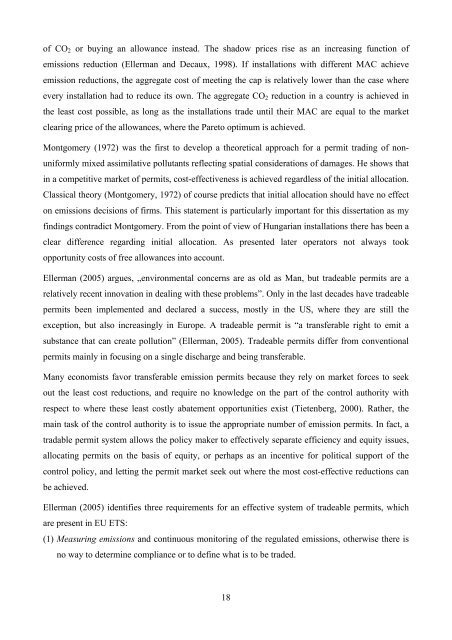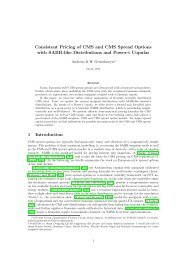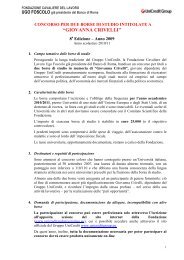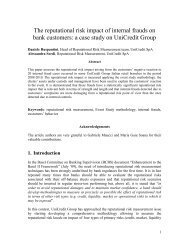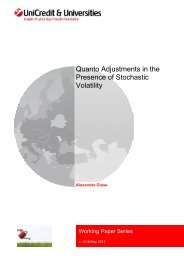Dóra Fazekas Carbon Market Implications for new EU - UniCredit ...
Dóra Fazekas Carbon Market Implications for new EU - UniCredit ...
Dóra Fazekas Carbon Market Implications for new EU - UniCredit ...
You also want an ePaper? Increase the reach of your titles
YUMPU automatically turns print PDFs into web optimized ePapers that Google loves.
of CO2 or buying an allowance instead. The shadow prices rise as an increasing function of<br />
emissions reduction (Ellerman and Decaux, 1998). If installations with different MAC achieve<br />
emission reductions, the aggregate cost of meeting the cap is relatively lower than the case where<br />
every installation had to reduce its own. The aggregate CO2 reduction in a country is achieved in<br />
the least cost possible, as long as the installations trade until their MAC are equal to the market<br />
clearing price of the allowances, where the Pareto optimum is achieved.<br />
Montgomery (1972) was the first to develop a theoretical approach <strong>for</strong> a permit trading of non-<br />
uni<strong>for</strong>mly mixed assimilative pollutants reflecting spatial considerations of damages. He shows that<br />
in a competitive market of permits, cost-effectiveness is achieved regardless of the initial allocation.<br />
Classical theory (Montgomery, 1972) of course predicts that initial allocation should have no effect<br />
on emissions decisions of firms. This statement is particularly important <strong>for</strong> this dissertation as my<br />
findings contradict Montgomery. From the point of view of Hungarian installations there has been a<br />
clear difference regarding initial allocation. As presented later operators not always took<br />
opportunity costs of free allowances into account.<br />
Ellerman (2005) argues, „environmental concerns are as old as Man, but tradeable permits are a<br />
relatively recent innovation in dealing with these problems”. Only in the last decades have tradeable<br />
permits been implemented and declared a success, mostly in the US, where they are still the<br />
exception, but also increasingly in Europe. A tradeable permit is “a transferable right to emit a<br />
substance that can create pollution” (Ellerman, 2005). Tradeable permits differ from conventional<br />
permits mainly in focusing on a single discharge and being transferable.<br />
Many economists favor transferable emission permits because they rely on market <strong>for</strong>ces to seek<br />
out the least cost reductions, and require no knowledge on the part of the control authority with<br />
respect to where these least costly abatement opportunities exist (Tietenberg, 2000). Rather, the<br />
main task of the control authority is to issue the appropriate number of emission permits. In fact, a<br />
tradable permit system allows the policy maker to effectively separate efficiency and equity issues,<br />
allocating permits on the basis of equity, or perhaps as an incentive <strong>for</strong> political support of the<br />
control policy, and letting the permit market seek out where the most cost-effective reductions can<br />
be achieved.<br />
Ellerman (2005) identifies three requirements <strong>for</strong> an effective system of tradeable permits, which<br />
are present in <strong>EU</strong> ETS:<br />
(1) Measuring emissions and continuous monitoring of the regulated emissions, otherwise there is<br />
no way to determine compliance or to define what is to be traded.<br />
18


